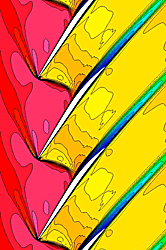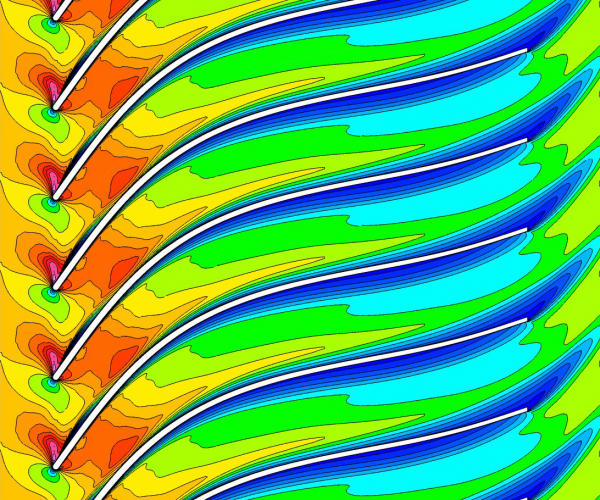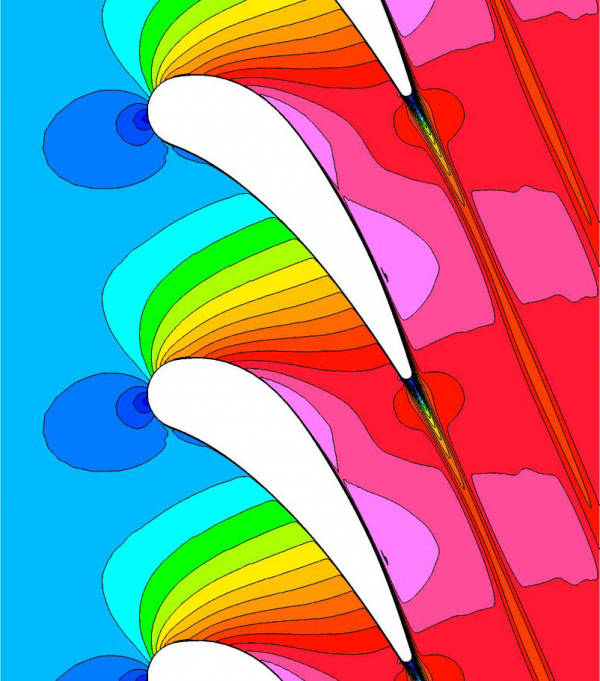RVCQ3D
RVCQ3D v. 406
Overview
RVCQ3D (Rotor Viscous Code Quasi-3-D) is a computer code for analyzing inviscid and viscous blade-to-blade flows in turbomachinery. It includes the quasi-3-D effects of rotation, radius change, and variable stream surface thickness. Simple flat plate and duct geometries can also be analyzed.
Applications
- Axial compressors and turbines
- Centrifugal impellers and radial diffusers (no splitters)
- Pumps
- Linear cascades
- Flat plates and rectangular ducts
- Fast parametric studies of blade shape, incidence angle, etc.
- CFD and turbomachinery education
Formulation and differencing schemes
RVCQ3D solves the Euler or Navier-Stokes equations written on a surface of revolution. The equations are written in an (m,theta)coordinate system, where m is the arc length along the surface and theta is the circumferential direction. The stream surface radius and thickness are assumed to be known functions of m, and are usually obtained from an axisymmetric throughflow analysis.
- Central difference + artificial viscosity
- Central difference + H-CUSP upwind
- AUSM+ upwind scheme
Turbulence models
- Baldwin-Lomax (algebraic)
- Cebeci-Smith (algebraic)
- Wilcox’s 2006 k-omega (two-equation) with cross diffusion term and stress limiter
All turbulence models include transition and roughness effects.
Numerical method
- Explicit multi-stage Runge-Kutta scheme
- Variable time-step and implicit residual smoothing for convergence acceleration
- Preconditioning for low-speed (incompressible) flows
Input and output
- Grids are usually generated using GRAPE
- Grid and solution files are in PLOT3D format
- Namelist input
- Printed output of convergence history, blade surface properties, and average flow properties at the inlet and exit
Computer and graphics requirements
RVCQ3D requires a Fortran 90 compiler and CFD visualization software for use. Click the button below for more information.
GRAPE, RVCQ3D, TCGRID, and SWIFT
The sites linked below are outside the NASA domain and are not endorsed by NASA.
Computer requirements
All codes are supplied as Fortran source code and require a Fortran 90 compiler for use. The Cray, Compaq, GNU, Intel, and SGI compilers have all been used successfully. The codes are usually run on Linux systems, butwill run on on a PC or Mac. Parallel processing is available on multi-core computers using OpenMP directives. Check the Fortran Store for information on Fortran compilers
Graphical output
No graphical output is provided with these codes, but access to some CFD visualization software is required to view and evaluate the grids and solutions. Grid and solution files are in standard PLOT3D format and can be read directly and plotted with the public-domain CFD visualization tool PLOT3D, or the commercial tools FieldView, TecPlot, or EnSight CFD. Check the following web sites for information on CFD visualization software.
Test cases included with RVCQ3D 406




